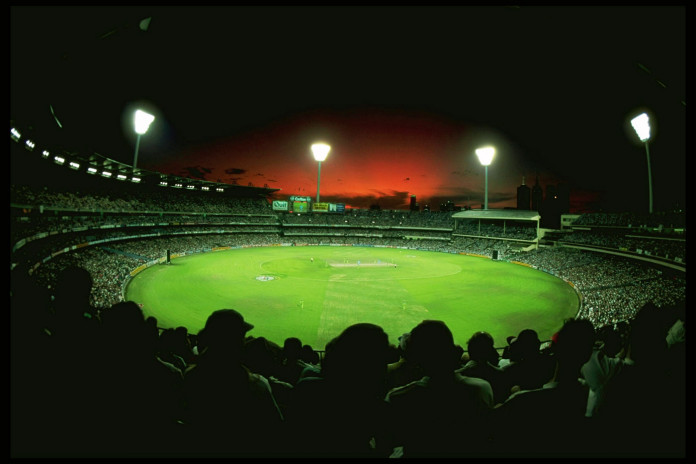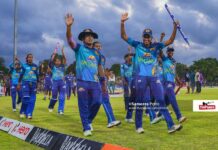On the 27th of November, it was not only the trans-Tasman rivalry that took a fresh turn but also the entire world of cricket.
The floodlit Adelaide Oval welcomed 48,000 spectators to grace the momentous occasion as the longest format of the game was introduced to day-night cricket after 138 years of existence. The traditional white kits remained, as pink coloured balls were introduced for the first time. It was a daring escapade for both sides as well as a pristine sensation for the crowd.
Day-night cricket dates back to as far as 1952 when the first day-night cricket match was played between Arsenal FC and Middlesex at Highbury Stadium, North London. But it failed to really capture the imagination of the cricketing world.
Kerry Packer’s giant leap
It was the media mogul Kerry Packer whose experiment paved the way for the ultimate makeover in world cricket. Constant disagreements between Packer and Cricket Australia did not hinder him in his bid to shepherd the radical transposition of cricket in late 1970’s. In came World Series Cricket, Packer’s own circuit where the best players were recruited from all around the world.
Parallel to the ‘Supertests’, the WSC International Cup was played between World Series Cricket Australia XI, World XI and West Indies XI. And on December 14th 1977, WSC Australia played WSC World XI under floodlights at VLF Park. Coloured clothing, white balls and black sight screens were introduced. A million dollar investment by Packer was set in motion.
On the 28th of November 1978, Day night cricket made its journey to Sydney. As WSC West Indies and WSC Australia battled it out, more than 50,000 spectators swamped into the SCG to witness the spectacle. The crowd was intrigued by the new phenomenon and after a rapturing display, WSC Australia won by 5 wickets. Packer’s gamble had paid off. It was certain; the game had taken a profound turn, ‘pyjama cricket’ was born.
It became official
On the 27th of November 1979, West Indies and Australia met once again at the SCG and this time it was official. The 75th ODI in history became the first ever day-night international encounter. Kerry Packer’s refutes with the ACB was solved. Television rights were negotiated and the player contracts were renewed after most of the WSC Australians had been banned from touring England for the World Cup a few months earlier.
The first ever official D/N ODI was won by Australia. Winning the toss, Australia invited the Windies to bat first. Alvin Kallicharran’s 49 stood out in a modest 193 which was comfortably chased down by Australia under lights, losing just 5 wickets. Skipper Greg Chappell, the eventual man of the match scored 74 while Kim Hughes scored 52.
The gradual expansion
On the following day, the West Indies played England at the SCG. England won by 2 runs, claiming their first ever day-night ODI victory. Five years later, on the 28th of September 1984, the Jawaharlal Nehru Stadium in Delhi became only the second stadium to host a day-night ODI. The game between Australia and India resulted in a victory to the visitors by 48 runs. Kepler Wessels scored a mesmerizing century for Australia.
In 1985, the majestic MCG hosted its first ever day-night ODI. Colossal floodlights standing at 85m were the tallest of any cricket venue. Australia beat England by 7 wickets amidst the roar of 85,000 fans. A year later, Perth hosted its first ODI under floodlights.
Floodlight tales of SriLanka
Sri Lanka played its first day-night ODI in 1985 against Australia at the SCG. Duleep Mendis captained Sri Lanka while the Australians were under the leadership of Alan Border. The hosts won by 6 wickets. Sri Lanka’s first ever day-night win came 4 years later against Pakistan on new year’s eve at Perth. The Lankans beat Imran Khan’s star studded side by 3 wickets. Athula Samarasekera was man of the match in the game in which Arjuna Ranatunga captained.
In 1992, when Sri Lanka played Australia at the RPS, it became only the second venue in the world (after Nehru stadium Delhi) to host a day-night ODI outside Australia. The two teams met again in another landmark occasion four years later as the 1996 World Cup final at Lahore became the first day-night ODI on Pakistani soil.
So far, Sri Lanka has played 347 day-night ODIs, winning 169 and losing 157.
Day-Night Cricket across the World
On 7th December 1992, South Africa hosted its first day-nighter against India at Cape Town. The Proteas won by 6 wickets. In 1996 McLean Park, Napier became the venue for the first day-night ODI in New Zealand when it hosted Zimbabwe. The visitors Zimbabwe won the match by 21 runs.
In 1997, Sharjah held its first day-night encounter becoming the first venue in a non-test playing nation to host a day-night ODI while the Bangabandhu Stadium in Dhaka hosted its first day-night adventure in 1998.
West Indies and England were the last two test playing nations to host day-night cricket. The fathers of cricket embraced the revolution in 2000 when Bristol hosted a day-night game between Zimbabwe and West Indies. Gros Islet at St. Lucia welcomed floodlit cricket in 2006.
Out of the test playing nations, Zimbabwe is the only one yet to host a day-night ODI.
Day-Night at the Pinnacle
In 1992 the World Cup moved to the southern hemisphere for the first time as Australia and New Zealand were given the opportunity to stage the event. It was a colourful, vibrant and moreover a revolutionary one. Not only did it mark the return of South Africa to world cricket following the apartheid, significant transformations such as coloured clothing, floodlit games, white balls and refined fielding circles and the appalling ‘rain rule’ symbolized a momentous makeover in the sport. The first day-night world cup game was played between India and England in Perth.
Later, on the 25th of March 1992, the MCG crowd of 87,125 welcomed Pakistan and England at the first ever day-night World Cup final. Pakistan beat England by 22 runs and hoisted the World Cup trophy amidst the radiant floodlights at the enormous MCG.
The day-night version, informally known as pyjama cricket, was an outstanding result of many efforts to revolutionize cricket. Today it has made its voyage through T20s to the longest format of the game. A concept that cropped up amidst moots and disputes, but a momentous makeover that forever changed the gentlemen’s game.



















